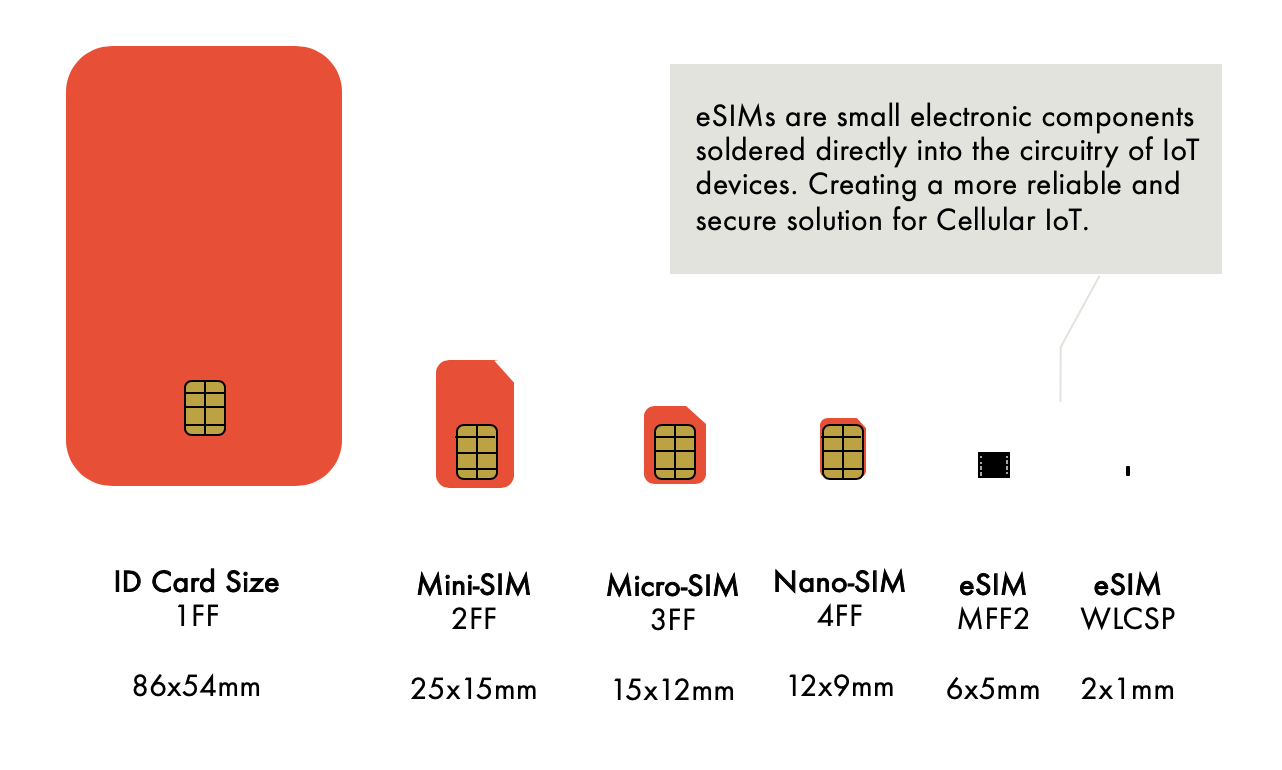SIM Cards types
Learn about SIM cards, its type, its application, its quality and its formats
Standard vs. Industrial SIM
The standard simcards are suitable for stationary objects in normal circumstances when it comes to (e.g.) temperature or humidity.The industrial simcards are recommended for moving objects, smart metering applications and other similar things (under more extreme conditions).
Although, a standard simcard can have a lifetime of more than 10 years, the default lifetime is estimated on 2 - 5 years where the default lifetime of an industrial simcard is estimated at 5 - 10 years. These calculations are based on the expectation that there will be frequent sim activity (which should not be the case for LPWA).
You can find more details about our simcards below.
Feel free to post a topic on our forum https://forum.iotcreators.com/ if you're missing information.
| STANDARD SIM | INDUSTRIAL SIM | |
|---|---|---|
Target segment | Connected consumer electronics | Industrial: Security Smart metering Automation, monitoring & control Retail & commerce Mobile: Vehicle telematics Transport, logistics, tracking |
Typical operation conditions | Classic CE Environment Indoor | Industrial: (Semi-)stationary machines & equipment Building infrastructure (inhouse) Protected outdoor infrastructure Moving goods & machines Vehicle telematics equipment Mobile: Moving goods & machines * Vehicle telematics equipment |
| Typical usage profile | Modest (e.g on average 1-2 SIM events/hour) | Potentially high (e.g. 1 event/minute) |
| Typical product lifetime | 2-5 years | 5-10 years |
Applicable ETSI 102 671 EPI: | TS-RA-UB-MA TS: -25°C/+85°C Temperature range (ideally -35°C/+85°C) RA: 10 years Data Retention Time UB: 500k minimum update cycles MA: Moisture/reflow conditions acc. to JEDEC J-STD-020D (MFF2) | TB-MA-HA-RA-UB TB: -40°C/+105°C Temperature range MA: Support of automotive moisture/reflow condition (MFF2 only) HA: Support of high humidity condition RA: 10 years Data Retention Time (here: @85°C) UB: 500k minimum update cycles |
eSIM
eSIM stands for embedded SIM (or electronic SIM) and both eSIM and SIM are compatible with the GSMA remote provisioning standards.
The remote SIM provisioning are eSIM/eUICC specifications which allow Enterprises to change and activate the SIM profile embedded in IoT devices remotely or over the air (OTA).
There are currently two remote provisioning specifications – M2M and Consumer – both of which simplify the logistics process for device distribution. While the consumer implementation is intended for devices such as smartphones, smartwatches, tablet computers, and fitness bands, the M2M solution serves all other IoT devices in B2B and B2B2C markets.
Consumer Market
In the consumer market, smartwatches and eSIMs are well aligned. The small form-factor smartwatch requires miniaturised components, and eSIM comes in MFF2 (6x5mm) and WLCSP (2x1mm) packages which are solderable. The eSIM is embedded in the watch which means it cannot be removed. Although this brings benefits of security and reliability, it does create the need for remote (OTA) provisioning and management. There is of course a standard process for this, and it is described by the GSMA’s ‘Remote SIM Provisioning (RSP) Architecture for Consumer Devices‘.
The GSMA has estimated that smartwatch adoption has exceeded 15% of adults (25% of adults aged 18-34 years) in the USA. In Europe and China, the numbers are around 10% and 15-20% respectively. Adoption by Apple, Huawei, Samsung and Mobvoi means the eSIM opportunity in smartwatches will only grow. Likewise in smartphones, where Apple iPhone and Google Pixel are already deploying with eSIM. Will the Chinese manufacturers follow?
The biggest challenge to eSIM adoption is currently regulation, and significant work is under way to set a favourable regulatory framework. Some business models are still uncertain and there is diversity and fragmentation within the IoT market, but despite all these challenges, eSIM adoption is growing faster than ever before.
M2M IoT Market
Smartwatches and smartphones have the advantage of a user interface (the screen) and a user (us!) who can make connectivity choices. IoT devices typically do not have either of these features, and this creates a different set of challenges and a different architecture.
These applications require the network to control and automate decision making around IoT connectivity and the GSMA’s ‘Remote Provisioning Architecture for Embedded UICC (eUICC)’ is a solution which Arkessa has been providing to customers for 12 months already.
M2M solutions for industries such as automotive, healthcare, transport, and utilities cannot rely on end user interaction and so Remote SIM Provisioning for M2M follows a server-driven model to remotely provision operator profiles.
| 3 Key elements for remote provisioning |
|---|
| eUICC – a secure element that features one or more subscription profiles. eUICC is compatible with eSIM and removable SIMs. In effect, each profile enables the eUICC to function like a removable SIM. |
| SM-DP (Subscription Manager – Data Preparation) – responsible for preparing, storing and protecting operator profiles and for downloading and installing profiles onto the eUICC. |
| SM-SR (SM-SR (Subscription Manager – Secure Routing) – responsible for managing (enabling, disabling, deleting) profiles on eUICC and securing the communication link between eUICC and SM-DP for the delivery of operator profiles. |
An connectivity management platform with service support for eUICC technology enables global IoT deployments at scale using a single factory-installed eSIM or SIM (a single SKU).
An connectivity management platform allows an eSIM or SIM to localise once an IoT device is deployed, anywhere in the world. eSIM-compatible eUICC technology simplifies manufacturing, logistics and deployment, keeps costs down and enables secure and resilient global scalability for IoT.
nuSIM
For the nuSIM SIM Function goes into the modem chip.
With the nuSIM the physical SIM is gone!
- No related contacts, circuit, space requirements
- No specific SIM logistics, handling, stock keeping
- Optimized internal functionality & interfaces
SIM Card Formats

Updated almost 3 years ago
